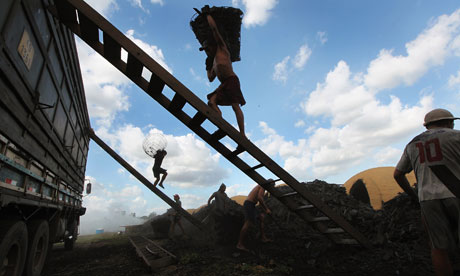Source: guardian.co.uk
Slavery was abolished by most countries 150 years ago, but bonded and forced labour, trafficking and exploitation persist
Annie Kelly
guardian.co.uk,

A worker carries a bag
of charcoal on to a truck in Rondon do Para. Brazil was the last
country to withdraw from the transatlantic slave trade. Photograph:
Mario Tama/Getty
What is modern-day slavery?
About 150 years after most countries banned slavery – Brazil was the last to abolish its participation in the transatlantic slave trade, in 1888 – millions of men, women and children are still enslaved. Contemporary slavery takes many forms, from women forced into prostitution, to child slavery in agriculture supply chains or whole families working for nothing to pay off generational debts. Slavery thrives on every continent and in almost every country. Forced labour, people trafficking, debt bondage and child marriage are all forms of modern-day slavery that affect the world's most vulnerable people.How is slavery defined?
Slavery is prohibited under the 1948 Universal Declaration of Human Rights, which states: "No one shall be held in slavery or servitude: slavery and the slave trade shall be prohibited in all their forms."Definitions of modern-day slavery are mainly taken from the 1956 UN supplementary convention, which says: "debt bondage, serfdom, forced marriage and the delivery of a child for the exploitation of that child are all slavery-like practices and require criminalisation and abolishment". The 1930 Forced Labour Convention defines forced labour as "all work or service which is exacted from any person under the menace of any penalty and for which the said person has not offered himself voluntarily".
As contemporary systems of slavery have evolved, new definitions, including trafficking and distinguishing child slavery from child labour, have developed.
Some of the forms of slavery are:
Bonded labour: people become bonded labourers after falling into debt and being forced to work for free in an attempt to repay it. Many will never pay off their loans, and debt can be passed down through the generations.
Forced labour: where people are forced to work, usually with no payment, through violence or intimidation. Many find themselves trapped, often in a foreign country with no papers, and unable to leave.
Descent-based slavery: where people are born into slavery because their families belong to a class of "slaves" within a society. The status of "slave" passes from mother to child.
Trafficking: the transport or trade of people from one area to another and into conditions of slavery.
Child slavery: children are in slavery as domestic workers, forced labour – in, for example, the cocoa, cotton and fisheries industries – trafficked for labour and sexual exploitation, and used as child soldiers.
Early and forced marriage: women continue to be married without consent, often while still girls, and forced into sexual and domestic servitude.
How many people are enslaved across the world?
Due to its illegality, data on modern-day slavery is difficult to collate. The UN's International Labour Organisation (ILO) estimates that about 21 million people are in forced labour at any point in time. The ILO says this estimate includes trafficking and other forms of modern slavery. The only exceptions are trafficking for organ removal, forced marriage and adoption, unless the last two practices result in forced labour.The ILO calculates that 90% of the 21 million are exploited by individuals or companies, while 10% are forced to work by the state, rebel military groups, or in prisons under conditions that violate ILO standards. Sexual exploitation accounts for 22% of slaves.
On trafficking – that is, people trapped in forced labour as a result of internal or cross-border migration – the ILO calculates that 29% end up in forced labour after crossing international borders, the majority through trafficking for sexual exploitation. About 56% of the 21 million are exploited where they live.
Where does slavery exist?
Slavery exists in one form or another in every country. Asia accounts for more than half of the ILO's 21 million estimate. In terms of percentage of population, central and south-east Europe has the highest prevalence of forced labour, followed by Africa, the Middle East, Asia Pacific, Latin America and the Caribbean.Who is affected?
Although modern-day slavery affects a cross-section of the population, some groups are more vulnerable. Unsurprisingly, women and girls are more at risk than men and boys. Women make up the majority of those being exploited – 55% are women and girls, and account for the vast majority of sexually exploited people.Children make up a quarter of all those in slavery.
Slaves usually come from the most vulnerable, minority or socially excluded groups. For instance, forced and bonded labour is often interlinked with the caste system in south Asia. Caste-based slavery is carried down through the generations, embedded in traditional beliefs and customs, and underpinned by cultural discrimination. Anti-Slavery International estimates that 80-98% of bonded labourers in the region are from dalit (formerly "untouchable") or indigenous communities. Migrant workers are also highly vulnerable.
Who is profiting?
In 2005, the ILO estimated that illegal profits from forced labour amounted to more than $44bn. The UN's global initiative to fight trafficking says people trafficking is the third-largest global criminal industry (pdf) behind drugs and arms trafficking.The ILO estimates that people in forced labour lose at least $21bn each year in unpaid wages and recruitment fees. Given that remittances to developing countries account for more than three times the global aid budget, there is an impetus for governments to ensure that migration for work is not manipulated by traffickers.
Slavery also exists within global supply chains, generating huge profits for those who control this industry in free labour. Recent economic research has shown that forced labour has broader social and economic costs, in terms of impeding economic development and increasing or perpetuating poverty.


No comments:
Post a Comment